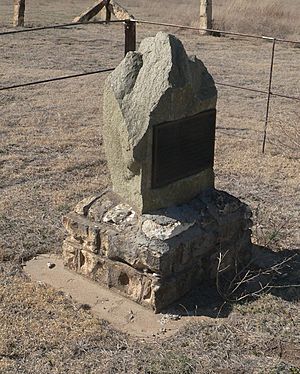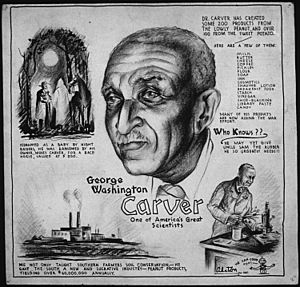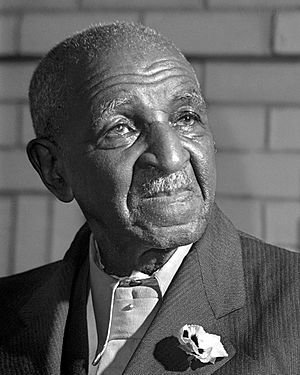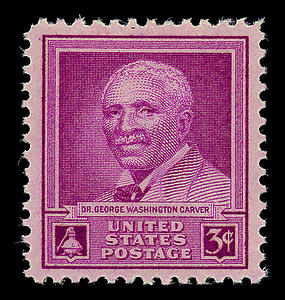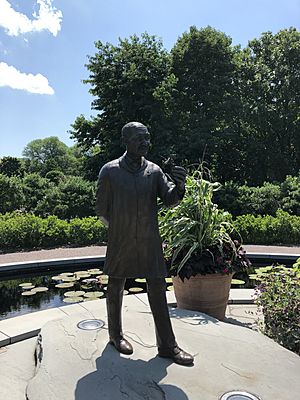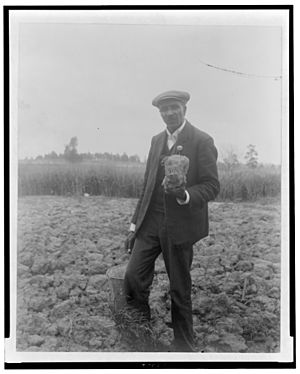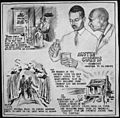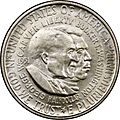George Washington Carver facts for kids
Quick facts for kids
George Washington Carver
|
|
|---|---|
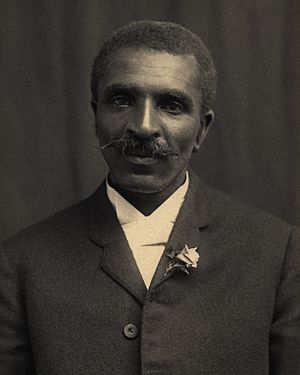
Photograph circa 1910
|
|
| Born | 1864 Diamond, Missouri, U.S.
|
| Died | January 5, 1943 (about 79 years old) Tuskegee, Alabama, U.S.
|
| Alma mater | Iowa State University |
| Awards | Spingarn Medal (1923) |
| Signature | |
George Washington Carver (c. 1864 – January 5, 1943) was an African American agricultural scientist and inventor. He taught southern farmers to plant crops other than cotton and methods to prevent soil depletion. Apart from his work to improve the lives of farmers, Carver was also a leader in promoting environmentalism. He received numerous honors for his work, including the Spingarn Medal of the NAACP.
Contents
Early years
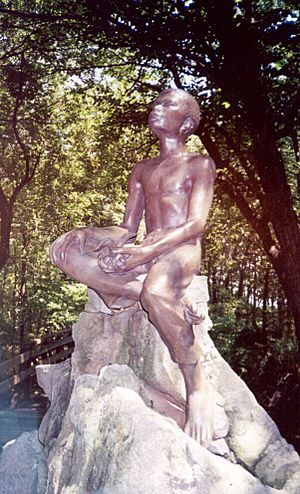
George Washington Carver was born into slavery in Diamond Grove, Newton County, near Crystal Place, now known as Diamond, Missouri, during the early to mid 1860s. The exact date of his birth is uncertain and was not known to Carver – however, it was before slavery was eliminated in Missouri in January 1865, after the American Civil War. His master, Moses Carver, was a German-American immigrant who had purchased George's parents, Mary and Giles, from William P. McGinnis on October 9, 1855, for $700.
When George was only a week old, he, a sister, and his mother were kidnapped by night raiders from Arkansas. George's brother, James, was rushed to safety from the kidnappers. The kidnappers sold the slaves in Kentucky. Moses Carver hired a Union scout named John Bentley to find them, but Bentley was only able to locate the infant George. Moses made a deal with the raiders for George's return and rewarded Bentley for finding him. After slavery was eliminated, Moses Carver and his wife Susan raised George and his older brother James as their own children. They encouraged George in his schooling, and "Aunt Susan" taught him the basics of reading and writing.
Black people were not allowed to attend the public school in Diamond Grove. George decided to go to a school for black children 10 miles (16 km) south in Neosho. When he reached the town, he found the school closed for the night, so he slept in a nearby barn. The next morning he met a kind woman, Mariah Watkins, from whom he wished to rent a room. When he introduced himself as "Carver's George," as he had done his whole life, she replied that from now on his name was "George Carver." George liked Mariah Watkins, and her words, "You must learn all you can, then go back out into the world and give your learning back to the people," made a great impression on him.
At the age of 13, due to his desire to attend the academy in Fort Scott, Kansas, he relocated to the home of another foster family there. He attended several schools before earning his diploma at Minneapolis High School in Minneapolis, Kansas.
College education
Carver applied to several colleges before being accepted at Highland University in Highland, Kansas. When he arrived, however, they rejected him because of his race. In August 1886, Carver traveled by wagon from Highland to Eden Township in Ness County, Kansas. He homesteaded a claim near Beeler, where he maintained a small conservatory (a building or room where plants are grown) of plants and flowers and a geological collection. He manually plowed 17 acres (69,000 m2) of the claim, planting rice, corn, Indian corn, and garden produce, as well as various fruit trees, forest trees, and shrubbery. He also earned money by performing odd jobs in town and working as a ranch hand.
In early 1888, Carver obtained a $300 loan at the Bank of Ness City for education, and by June he left the area. In 1890, Carver started studying art and piano at Simpson College in Indianola, Iowa. His art teacher, Etta Budd, recognized Carver's talent for painting flowers and plants; she encouraged him to study botany at Iowa State Agricultural College (now Iowa State University) in Ames.
When he began there in 1891, he was the first black student at Iowa State. Carver's Bachelor's thesis for a degree in Agriculture was "Plants as Modified by Man," dated 1894. Iowa State University professors Joseph Budd (Etta's father) and Louis Pammel convinced Carver to continue there for his master's degree. Carver did research at the Iowa Experiment Station under Pammel during the next two years. His work at the experiment station in plant pathology and mycology caused Americans to recognize and respect him as a botanist. Carver received his master of science degree in 1896 and taught as the first black faculty member at Iowa State.
Tuskegee Institute
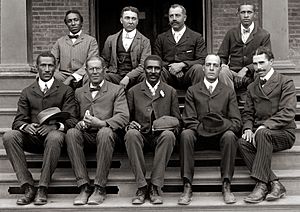
In 1896, Booker T. Washington invited Carver to head the Agriculture Department at Tuskegee Institute. Carver taught there for 47 years, developing the department into a strong research center. Carver accomplished much during his time at Tuskegee Institute: He taught methods of crop rotation. He introduced several other cash crops for farmers that would also improve the soil of areas that only grew cotton. He started research into crop products and taught generations of black students farming methods for self-sufficiency.
Carver was as concerned with his students' character development as he was with their intellectual development. He wrote a list of eight virtues for his students to strive toward:
- Be clean both inside and out.
- Neither look up to the rich nor down on the poor.
- Lose, if need be, without squealing.
- Win without bragging.
- Always be considerate of women, children, and older people.
- Be too brave to lie.
- Be too generous to cheat.
- Take your share of the world and let others take theirs.
Carver designed a mobile classroom to take education out to farmers. He called it a "Jesup wagon" after the New York financier and philanthropist Morris Ketchum Jesup, who gave Carver money to support the program.
Rise to fame
Carver developed ways to improve soils in which the nitrogen was used up by repeated plantings of cotton. Together with other agricultural experts, he urged farmers to put nitrogen back into their soils by practicing organized crop rotation: alternating cotton crops with plantings of sweet potatoes or legumes (such as peanuts, soybeans, and cowpeas). These crops restore nitrogen to the soil and are good for people to eat. Farmers who rotated their crops benefitted in two ways: their cotton grew better than before and they also had alternative cash crops. To train farmers to successfully rotate and cultivate the new crops, Carver developed an agricultural program for Alabama that was similar to the one at Iowa State.
Carver founded a research laboratory in which he and his assistants worked to make the new crops popular by developing hundreds of uses for them. They did original research and shared the crops' usefulness and recipes that they had collected from others. Carver distributed his information as agricultural bulletins. He wanted as many people as possible to have access to this valuable information.
Carver became one of the most well-known African Americans of his time. His work was known by officials in the national capital before he became a public figure. President Theodore Roosevelt publicly admired his work. In 1916, Carver was made a member of the Royal Society of Arts in England, one of only a handful of Americans at that time to receive this honor. Carver's promotion of peanuts gained him the most notice. The United Peanut Associations of America invited Carver to speak at their 1920 convention. He discussed "The Possibilities of the Peanut" and showed 145 peanut products.
From 1915 to 1923, Carver concentrated on researching and experimenting with new uses for peanuts, sweet potatoes, soybeans, pecans, and other crops, as well as having his assistants research existing uses. This work, and especially his testifying to Congress, made him widely known as a public figure. Carver noticed that U.S. peanut farmers were not making much money because the price of imported peanuts was less than the peanuts grown in the U.S. This caused him to speak before Congress in support of a tariff on imported peanuts, which Congress passed in 1922.
Life while famous
During the last two decades of his life, Carver seemed to enjoy his celebrity status. He was often on the road promoting Tuskegee Institute, peanuts, and racial harmony. Although he only published six agricultural bulletins after 1922, he published articles in peanut industry journals and wrote a newspaper column, "Professor Carver's Advice." Business leaders came to seek his help, and he often responded with free advice. Three American presidents—Theodore Roosevelt, Calvin Coolidge, and Franklin Roosevelt—met with him, and the Crown Prince of Sweden studied with him for three weeks. From 1923 to 1933, Carver toured white Southern colleges for the Commission on Interracial Cooperation.
With his increasing notability, Carver became the subject of biographies and articles. In 1932 it was written that Carver and his peanut products were almost solely responsible for the rise in U.S. peanut production after the boll weevil devastated the American cotton crop beginning about 1892.
From 1935 to 1937, Carver participated in the USDA Disease Survey. Carver had specialized in plant diseases for his master's degree. In 1937, Carver attended two chemurgy (the chemical and industrial use of organic raw materials) conferences during the Great Depression and the Dust Bowl, concerned with developing new products from crops. He was invited by Henry Ford to speak at a conference and they developed a close friendship.
Death
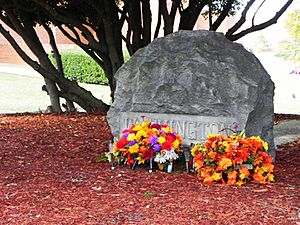
Upon returning home one day, Carver took a bad fall down a flight of stairs; he was found unconscious by a maid who took him to a hospital. Carver died January 5, 1943, at the age of 78 from complications resulting from this fall. He was buried next to Booker T. Washington at Tuskegee University.
On his grave is written: He could have added fortune to fame, but caring for neither, he found happiness and honor in being helpful to the world.
Carver's life savings totaled $60,000, all of which he donated to the Carver Museum and to the George Washington Carver Foundation.
Legacy
The George Washington Carver Museum at Tuskegee Institute was approved in 1938, built, and dedicated in 1941. The Museum held Dr. Carver's large collections of native plants, minerals, birds and vegetables; his products from the peanut, sweet potato and clays; and his many paintings, drawings, and textile art. In December 1947, a fire broke out in the Carver Museum, and much of the collection was damaged. Time magazine reported that all but three of the 48 Carver paintings at the museum were destroyed.
A movement to establish a U.S. national monument to Carver began before his death. Because of World War II, spending that did not help pay for the war had been banned by order of the President. Missouri senator Harry S. Truman sponsored a bill in favor of a monument. The bill was passed and on July 14, 1943, President Franklin D. Roosevelt dedicated $30,000 for the George Washington Carver National Monument west-southwest of Diamond, Missouri, the area where Carver had spent time in his childhood. This was the first national monument dedicated to an African American and the first to honor someone other than a president. The 210-acre (0.8 km2) national monument complex includes a bust of Carver, a ¾-mile nature trail, a museum, the 1881 Moses Carver house, and the Carver cemetery. The national monument opened in July 1953.
Carver was featured on U.S. 1948 commemorative stamps. From 1951 to 1954, he was pictured on a commemorative half dollar coin. A second stamp honoring Carver, with a value of 32¢, was issued on February 3, 1998, as part of the Celebrate the Century stamp sheet series.
In 1977, Carver was elected to the Hall of Fame for Great Americans. In 1990, Carver was inducted into the National Inventors Hall of Fame. In 1994, Iowa State University awarded Carver a Doctor of Humane Letters. In 2000, Carver was a charter inductee in the USDA Hall of Heroes as the "Father of Chemurgy." In 2002, scholar Molefi Kete Asante listed George Washington Carver as one of 100 Greatest African Americans.
In 2005, Carver's research at the Tuskegee Institute was made a National Historic Chemical Landmark by the American Chemical Society. On February 15, 2005, an episode of Modern Marvels included scenes from within Iowa State University's Food Sciences Building and about Carver's work.
Two ships, the Liberty ship SS George Washington Carver and the nuclear submarine USS George Washington Carver (SSBN-656), were named in his honor. Many institutions continue to honor George Washington Carver. A garden and statue of him are dedicated in the famous Missouri Botanical Gardens in St. Louis. Dozens of elementary schools and high schools are named after him. National Basketball Association star David Robinson and his wife, Valerie, founded an academy named after Carver; it opened on September 17, 2001, in San Antonio, Texas. The Carver Community Cultural Center, a historic center located in San Antonio, is named for him.
George Washington Carver quotes
- "Ninety-nine percent of the failures come from people who have the habit of making excuses."
- "Learn to do common things uncommonly well."
- "There is no shortcut to achievement. Life requires thorough preparation—veneer isn't worth anything."
- "It is simply service that measures success."
- "Start where you are, with what you have. Make something of it and never be satisfied."
- "I love to think of nature as an unlimited broadcasting station, through which God speaks to us every hour if we will only tune in."
- "Reading about nature is fine, but if a person walks in the woods and listens carefully, he can learn more than what is in books, for they speak with the voice of God."
- "The secret of my success? It is simple. It is found in the Bible."
Interesting facts about George Washington Carver
- George Washington Carver was famous for his work in Alabama but was born in Missouri.
- Carver considered many weeds "nature's vegetables" and would eat sandwiches made with them.
- George Washington Carver was the first African American to have a national park named after him.
- Carver possessed the hidden talents of a pianist and painter. His art was shown at the 1893 World's Fair in Chicago.
- He encouraged black farmers to grow peanuts. He developed and promoted many products made from peanuts, but none became successful in stores.
- Carver is often mistakenly given the credit for the invention of peanut butter. In fact, he did not do that.
- Carver helped Henry Ford make peanut rubber that was to be used for cannons.
- Carver believed that peanut oil could help those who suffered from polio, but no scientific evidence proved it.
- In 1941, Time magazine named Carver a "Black Leonardo."
- He was widely recognized and praised in the white community for his many achievements and talents.
See also
 In Spanish: George Washington Carver para niños
In Spanish: George Washington Carver para niños
- African-American history
- Carver Court, a historic housing development in Chester County, Pennsylvania
- George Washington Carver Center for Arts and Technology, a public high school in Towson, Maryland
- List of people on stamps of the United States
Images for kids


